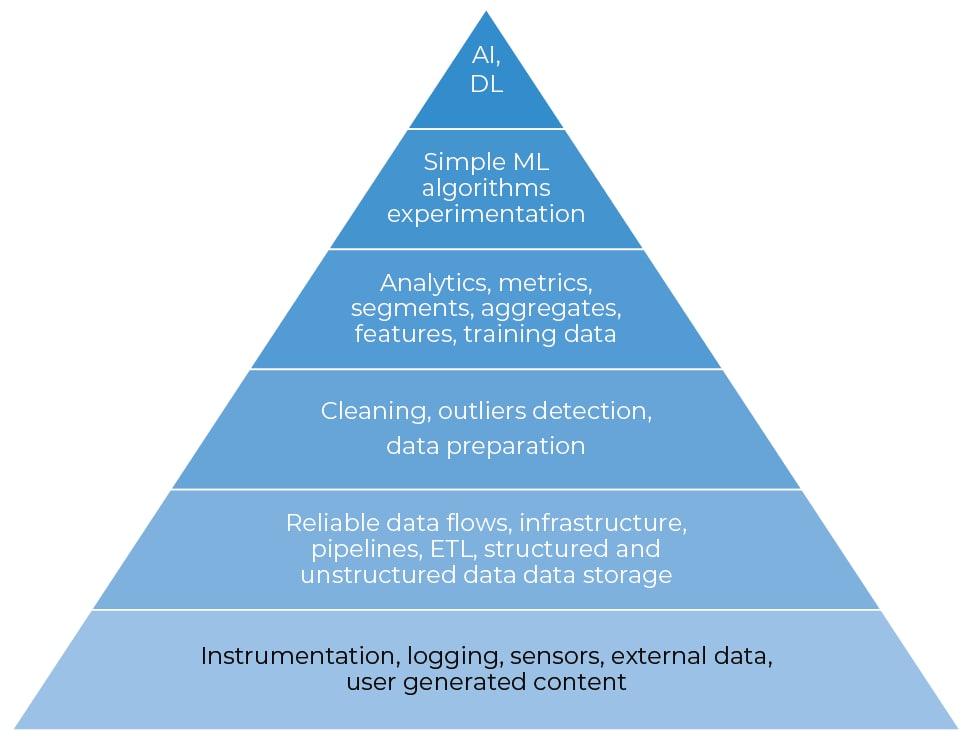An overview about digital transformation
There have been many talks about digital transformation lately, but not everyone knows what it is. However, this process is happening everywhere, and it is changing businesses entirely. Therefore, it is crucial to understand digital transformation and the benefits it can bring. In this article, we will describe the digital transformation process, discuss the steps to achieve it, and the challenges that may arise on the way.
Table of contents:
- What is the Digital Transformation process?
- Steps to Digital Transformation
- The Hierarchy of Needs
- Conclusion
What is the Digital Transformation process?
In layman’s terms, digital transformation is all about integrating digital technologies into business processes. This is done by replacing manual processes with digital ones or updating old digital techniques with newer ones.
Despite such a strict definition, digital transformation is a pretty broad concept that differs between industries and may include various processes. One might think about “going paperless” – when the document flow is transferred from the paper-based infrastructure to the digital one. Somebody else might think about cloud computing – the usage of cloud-based resources instead of on-premise hardware. Yet to another person, artificial intelligence may come to mind. These are all indeed examples of digital transformation.
Why would anyone want such a transformation? Well, it brings multiple benefits. First of all, digital transformation implies automation. Automation, in turn, leads to optimization, flexibility, and efficiency. Especially in times of pandemics, the ability to adapt to changes quickly is a key to survival and competitive advantages. There is also the customer experience side, which is transformed entirely. Finally, digital transformation may also become a catalyst for creativity and innovation.
So as not to be unfounded, here are a few interesting statistics from studies about digital transformation. According to the IDG’s State of Digital Business Transformation research, businesses that adopt digital strategies increase their revenue on average by 34%. Another study by MIT shows that digitally mature companies are 26% more profitable, generate 9% more revenue, and achieve 12% higher market valuations. And that is not the limit! Forbes posted a whopping 100 impressive statistics about digital transformation. Many of them will surprise you!
Steps to Digital Transformation
Because of its numerous benefits, digital transformation is already present in many industries: healthcare, banking, retail, education, etc. And even more businesses try to implement it to keep up. But how exactly is it done? Luckily for you, we have prepared an explanation of the five most essential steps on your way to a digital transformation, here they are:
- Preparing the data
- Understanding the technologies
- Building a portfolio
- Launching a pilot
- Scaling up
Let us take a look at each of these steps in detail.
Preparing the data
Data is the backbone of everything. Every decision-making process, every strategy, every solution starts with data. In fact, 90% of enterprise analytics and business professionals claim that data and data analysis are critical to any digital transformation initiative. The good news is that there is enough data in the modern world, as it is generated at an enormous speed. The bad news is that it is not as easy to work with them as it sounds.
Prior to embarking on your digital transformation, you need to become familiar with your data. You need to understand it, the constraints it has, whether it is possible to get meaningful results. Furthermore, you need to check the quality of the data. It is crucial to be aware of any pitfalls that may lurk in the process and know how to deal with them.
You may encounter many issues (some of them are listed here); we will discuss several data-related problems.
The first is about the data source. It includes cases like missing or incorrect data, duplicate values, and so on. Data engineers can usually solve this type of problem.
The second is related to the data itself: there might be problems with the data sample, but data engineers and data scientists should deal with such issues as well.
Finally, there are problems related to the data source or the data itself, but your team cannot solve them. An example would be a unique dataset, the author of which is not entirely trustworthy. The solution, in this case, would be to find a field expert to help you or collect your own data, if possible.
Understanding the technologies
Many projects are doomed to fail due to the lack of planning. Managers often rush into action without much consideration. It sometimes happens that the idea is too complicated or even impossible to implement in the current situation. The technology may not be powerful enough, or the solution you need might not exist yet. Anyway, it is crucial to do a little research before starting a project to determine the possibilities and limitations.
It is also essential to choose the most appropriate technology for the task, otherwise, the transfer to another tool in the middle of the project may be too costly and lengthy. The best solution would be to consult with an expert and make all the necessary choices in advance.
Building a portfolio
A portfolio is a prioritized set of tasks to implement in the first place. It is not easy, as many things have to be considered: main challenges and bottlenecks, tools, and deadlines. The idea is to plan every aspect of the project and objectively assess them.
Launching a pilot
A pilot is the first working launch of your project. It is a miniature version of your future application. The purpose of the pilot is to figure out if it is possible to solve the task with the available data and infrastructure. Pilots enable you to test the features, discover any failures or bugs, and investigate the possibilities of improving.
Scaling up
Scaling up is the final step in any project. It is the increase of the application to the size of the company. It includes building the capabilities, improving the production, and integrating with existing processes. Scaling up is crucial for a company’s growth.
For a successful scaling, several things must be present. Of course, there must be a working pilot and a team ready to increase its size. There must also be appropriate technical capabilities that will support the application’s needs. Finally, the company’s processes must allow integration with the new tool.
The Hierarchy of Needs
As it was mentioned earlier, digital transformation is a broad term. However, it looks like most of the attention goes to artificial intelligence as more and more companies try to integrate it into their business. Indeed, AI is a powerful tool that can offer lots of benefits, but it is not as easy as it sounds. There is a long road ahead leading up to AI, and not everyone is capable of finishing it.
The path to AI may be demonstrated in the form of a pyramid, and artificial intelligence is the apex. But everything starts with the data. There are many sources of data and many ways to collect it. Data also exists in different forms. Depending on the business, it may be tabular data, sensor data, texts, pictures, etc.
The next step is collecting and storing the data. With the vast amount of data being generated every day, it is crucial to store it efficiently. Therefore, appropriate technologies must be used: relational/non-relational databases, data warehouses, data lakes, etc. Moving the data through data pipelines is just as important and must be treated securely and reliably so you don’t lose anything (especially personal information).
The data exploration phase is probably the longest and the most complicated. To get actionable results, clean data must be used. Unfortunately, most of the real-life data is a mess and must, therefore, be cleaned and transformed. This is a job for a data engineer or data scientist, and the result of all other future steps will depend on how well the data is prepared.
The following stage allows for some simple analysis. Basic analytics and patterns may be explored even without any machine learning and artificial intelligence. There are already many tools that enable you to investigate the data. Tableau is one example. This stage usually serves as a basis for the following ML phase. The best data and features are chosen, future metrics are decided, and so on.
The next step is training. It is a stage of experimentation and optimization. Simple machine learning models and algorithms are used for more complex data analysis and application development.
We are finally arriving at the top of the pyramid. It is where the models are getting better and training on new data. This phase is vast and broad, as there is no strict boundary in terms of where the finish line is. It is always possible to improve the existing solution, use more sophisticated models or ensembles, and optimize the processes.
 Stages of digital transformation
Stages of digital transformation
Conclusion
Digital transformation is crucial for business survival in the modern world. It allows companies to adapt to new challenges and improve processes. Companies that ignore digital transformation processes are very likely to become obsolete, and ultimately, fail.
Luckily, it is easy to get started with the transformation. You only need data and a few people to work with it to begin. If the results are satisfactory, the team and its capabilities may be expanded. But the main point is that the world is moving towards data-driven processes and decisions, so it would be a significant loss to miss the chance to adopt this trend.




